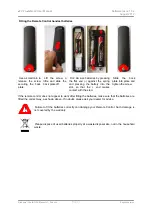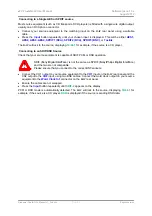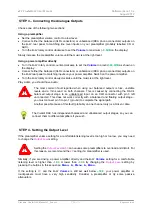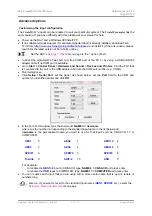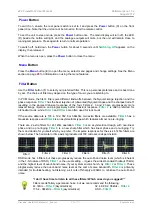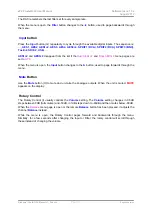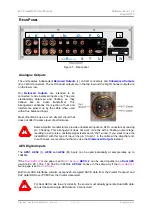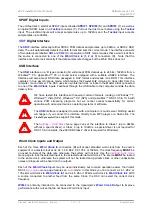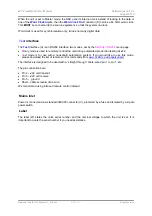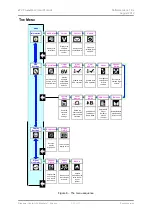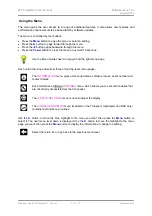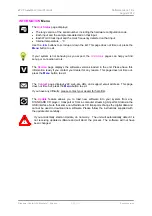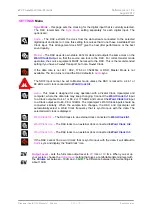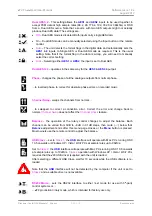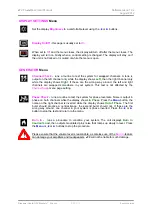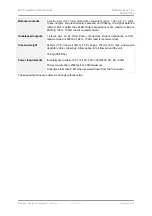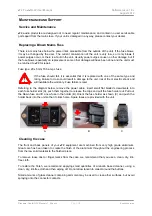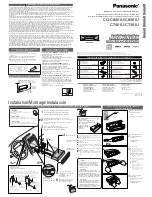
dCS Vivaldi DAC
User Manual
Software Issue 1.0x
August 2012
Filename: Vivaldi DAC Manual v1_0x.docx
Page 19
English
version
Power
Button
To switch on, ensure the rear panel switch is set to
I
and press the
Power
button (C) on the front
panel once. Note that the unit cannot be turned on from the remote control.
To set the unit to sleep mode, press the
Power
button once. The main display will turn off, the LED
(D) beside the button will light, and the analogue outputs will mute, but the unit will remain close to
running temperature. Press again to return to normal operation.
To switch off, hold down the
Power
button for about 3 seconds until
Switching Off
appears on the
display, then release it.
When the menu is open, press the
Power
button to close the menu.
Menu
Button
Press the
Menu
button (E) to open the menu, select menu pages and change settings. See the Menu
section on page
for information on using the menu features.
Filter
Button
Use the
Filter
button (F) to select your preferred filter. This is a personal preference and is best done
by ear. The choice of filter may depend on the type of music you are listening to.
In PCM mode, the first 4 filters give different trade-offs between the Nyquist image rejection and the
phase response.
Filter 1
has the best rejection of (unwanted) Nyquist images and the sharpest roll-off,
resulting in the poorest transient response of the four. Filters 2, 3 and 4 have progressively more
relaxed image rejection and progressively better transient response.
Filter 2
is often preferred for
orchestral music, while
Filter 3
and
Filter 4
are often used for rock music.
If the source data rate is 176.4, 192, 352.8 or 384kS/s, two extra filters are available.
Filter 5
has a
Gaussian response and
Filter 6
is an asymmetrical type which features almost no pre-ringing.
There are 2 extra filters for 44.1kS/s operation.
Filter 5
is an asymmetrical design with non-linear
phase and no pre-ringing.
Filter 6
is a new sharp filter which has linear phase and pre-ringing. Try
them and decide for yourself which you prefer. The impulse responses for the six 44.1kS/s filters are
shown below. The horizontal or time axis is graduated at 100 microseconds per division.
Filter 1
Filter 2
Filter 3
Filter 4
Filter 5
Filter 6
DSD mode has 4 filters, but these progressively reduce the out-of-band noise level (which is inherent
in the 1-bit nature of DSD).
Filter 1
is the usual setting – it gives the widest bandwidth (about 70kHz)
and the highest level of out-of-band noise. If your system sounds harsh, try
Filter 2
or
Filter 3
. These
progressively reduce the out-of-band noise level at the cost of some bandwidth.
Filter 4
is primarily
intended for troubleshooting, not listening, as it cuts off sharply at 20kHz to minimise the out-of-band
noise.
“I don’t have time to listen to all these filters! Which ones do you suggest?”
Filters are definitely a personal choice, but we can recommend the following:
44.1kS/s –
Filter 5
(asymmetrical) 32, 48, 88.2, 96kS/s –
Filter 2
176.4 - 384kS/s –
Filter 6
(asymmetrical) DSD –
Filter 1



